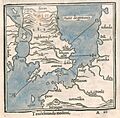Thomas Some (divine) facts for kids
Thomas Some, also known as Solme, was an English religious leader who lived in the 1500s. He was a Protestant, which meant he followed a different branch of Christianity than the official church at the time. Even though he became a monk, he didn't want to be one. He became a strong supporter of Protestant ideas and was a popular speaker during the reign of King Edward VI. When Queen Mary I came to power, she was Catholic and didn't support Protestants, so Thomas Some likely left England. One of his important writings, called The Lord's Flail, was ordered to be burned in 1546.
His Life Story
Thomas Some was born around 1509 or 1510. He was probably a canon at St. Osyth's Priory in Essex. A canon was a type of priest who lived in a religious community. In 1535, he wrote a letter to Thomas Cromwell, a powerful advisor to King Henry VIII. In his letter, Thomas Some asked to be freed from his life as a monk. He explained that he had been forced to join the monastery when he was only 14 years old, and he had been unhappy there for 12 years.
Thomas Some became a strong believer in Protestant ideas. Around 1540, he published his book called A Traetys callyde the Lordis Flayle. This book was printed in a city called Basel. Not long after, he was put in prison because of his religious beliefs. In July 1546, The Lord's Flail was one of the books that was publicly burned by Edmund Bonner, a bishop who opposed Protestants. This burning happened because King Henry VIII had made a rule against such books.
When King Edward VI became king, things changed for Protestants. Thomas Some became a very active and well-liked preacher. In 1549, he helped publish the famous sermons of Master Hugh Latimer, another important Protestant leader. Thomas Some wrote the introduction for this book, which was dedicated to Catherine Grey, Duchess of Suffolk. In 1551, he also added some Latin poems to a book by William Turner, who was a dean (a church leader) in Wells.
It seems that Thomas Some left England when Queen Mary I became queen, as she was known for persecuting Protestants. He likely died abroad around 1553 or shortly after.
His Writings
- A Traetys callyde the Lordis Flayle, published in Basel. This was his own book about his Protestant views.
- Introduction and dedication to Hugh Latimer's Seven Sermons, London, 1549. He helped bring Latimer's important speeches to print.
- Appended verses to William Turner's Preservative or Triacle, London, 1551. He contributed poems to this work.
See also
Images for kids



